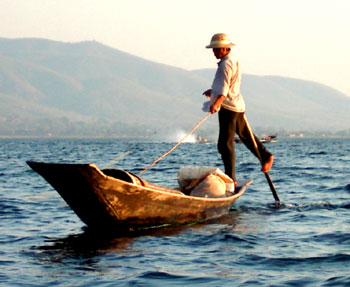"Row, row, row your boat..." On Myanmar’s
Inle Lake, the words to this old song take on a whole new meaning—for
Inle is the only place in the world where you can find people who propel
their boats by "leg rowing."
A beautiful, clear, natural lake surrounded by high green hills, Inle
is about 14 miles long by six miles wide. On the lake and along its rim
are 17 bamboo-and-wood villages, built on stilts, where about 150,000
people live, mostly members of the Intha tribe.
The Intha’s lives are centered on the lake—even their name
means "sons of the lake." Intha farmers grow flowers and vegetables,
including tomatoes, cabbages, beans, cauliflower, melons and papayas,
right on the lake—in floating beds of water hyacinth and grasses,
staked to the shallow lake bed with bamboo poles.
Even more unique are the Intha fishermen, who prowl the lake in their
small wooden boats and fish by scooping the water with conical-shaped
fish traps. Visitors to the area love taking photos of the fishermen
who propel their crafts by "leg rowing," a technique believed
to date back to the 12th century. Standing up on one leg in the narrow
stern of the boat, a fisherman wraps his other leg around an oar and,
with a circular movement, propels his boat forward. This "leg rowing" gives
him a better view of the waterways and makes it easier to navigate around
the floating islands and water hyacinth which make the margins of the
lake into a maze of passageways. It also frees his hands for managing
his fish trap.
Many of the lake’s villagers work in the small crafts factories,
which are also built on the pier-like villages, where they produce silk
and cotton textiles, cheroots, and silver and gold leaf craft ware.
Shopping takes place at the "five-day market," a colorful rotating
marketplace which shifts its ocation around the lake on a five-day schedule,
much like our farmer’s markets at home. People of various ethnicities—young
women with orange and black plaid turbans, old ladies smoking huge cigars,
and men wearing their wraparound longyis (sarongs), congregate at the
marketplace to bargain for all types of goods and produce.
Here, also, can be seen the "long-necked" women of the Padaung
tribe who, with a stack of heavy brass rings around their necks (giving
them a somewhat giraffe-like appearance), come down from their villages
to make money by posing for tourists’ photos.
Located around and in the lake are several monasteries, and each is worth
visiting. The most photographed of these temples is the Nga Phe Kyaung—the
eccentric "jumping cats" monastery where for the past 20 years,
monks, who enjoy the publicity, have trained their resident cats to jump
through small hoops, to the delight of tourists.
Myanmar, formerly known as Burma, is a strange country—the government
is a repressive military dictatorship, yet the people are some of the
nicest and friendliest in the world, and as you travel through the countryside,
you feel very welcome and safe. The unique cultures of the country, the
archaeological sites—highlighted by the thousands of ancient temples
at Bagan—and the beautiful scenery make Myanmar a destination well
worth adding to your next trip to Southeast Asia.
Click Here for information on our Myanmar (Burma) Tours.


 By
Lee Klein
By
Lee Klein
